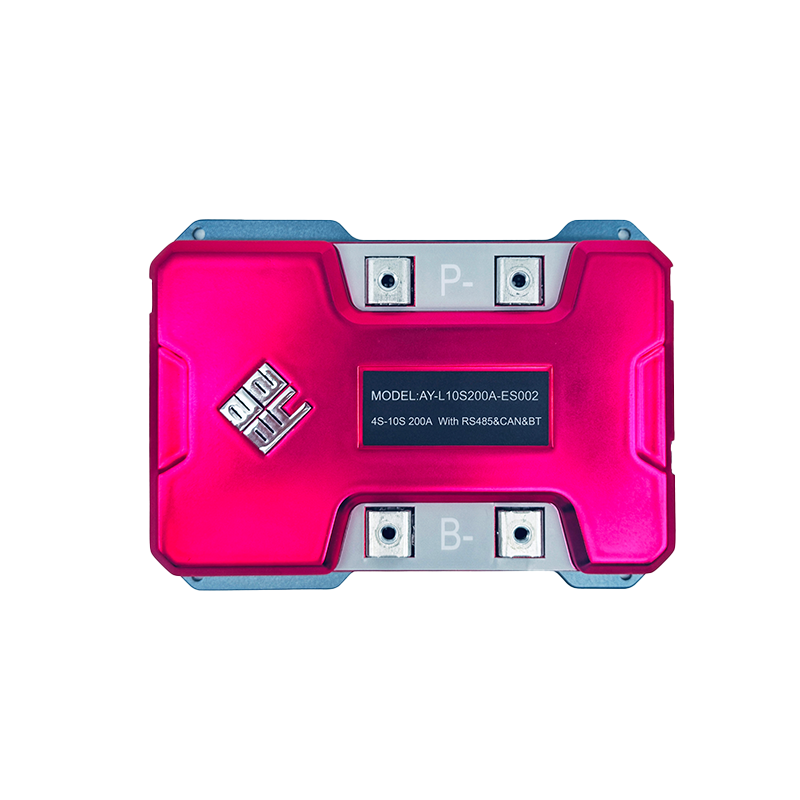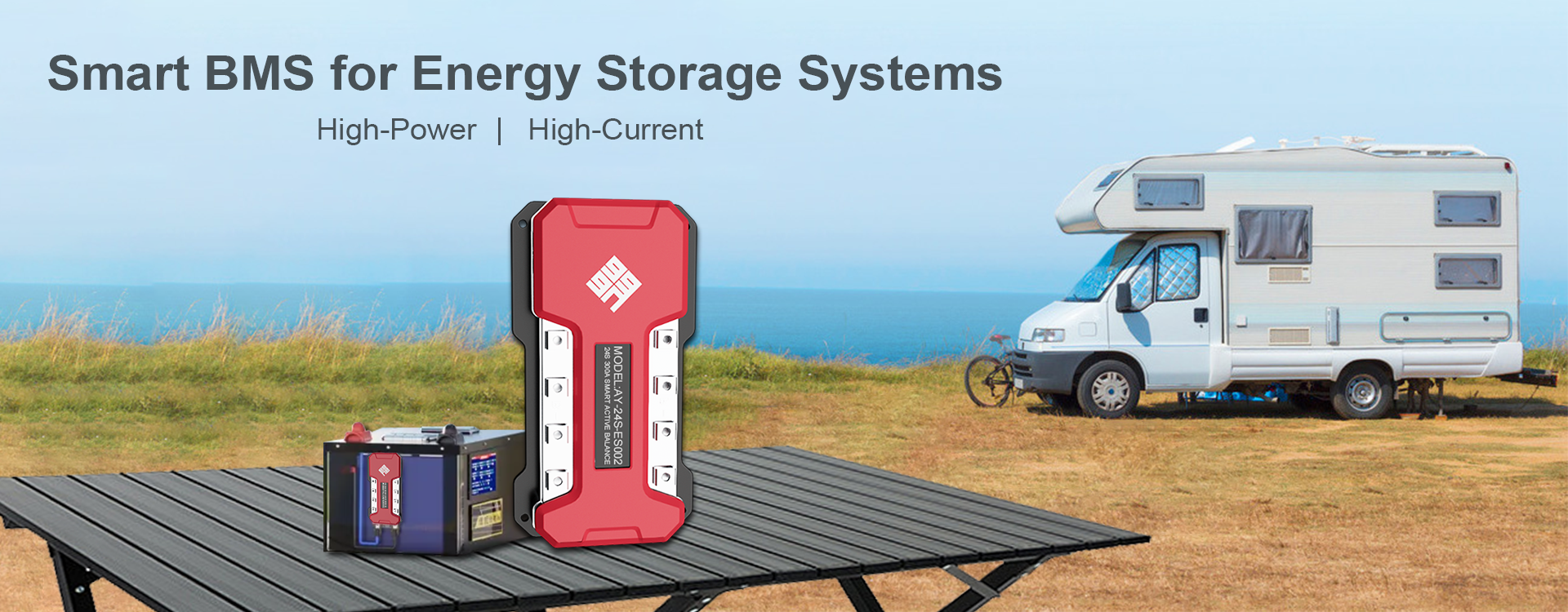

AYAA offers high-quality 8S-16S 200A BMS for 24V batteries, energy storage, and vehicles. We provide wholesale options, OEM/ODM services, and reliable factory supply.
In the era of renewable energy, the 24V battery with an 8S 24V BMS has become a cornerstone for home solar systems, commercial backup power, and industrial applications. This guide explores the technical pillars of the 8S 24V BMS, from active cell balancing algorithms to 200A MOSFET array designs, ensuring safety through ±1mV voltage sampling and <10ms short-circuit protection. We compare 24V battery and 48V systems (48V reduces line losses by 75%) and analyze thermal management secrets of brands like BYD and Daly (e.g., copper busbar cooling + smart fans). Whether you're a beginner or a maintenance expert, this article provides a step-by-step wiring guide and fault diagnosis strategies (e.g., EMI troubleshooting) to optimize your 8S-16S 200A BMS for energy storage.
The 24V battery with an 8S 24V BMS is a management system for eight series-connected lithium cells (e.g., LiFePO4 or NMC), delivering a nominal 25.6V (fully charged). The 8S 24V BMS ensures safe charging and discharging by monitoring voltage, temperature, and current, cutting off circuits during overvoltage (>3.65V/cell) or undervoltage (<2.5V/cell) to prevent thermal runaway. Key features include:
The 24V battery with 8S 24V BMS excels in mid-to-high-power applications like home solar storage and telecom backup, offering superior efficiency over 12V systems.
The 8S-16S 200A BMS for energy storage supports flexible 24V (8S) to 48V (16S) configurations and handles 200A continuous current (400A peak), ideal for electric boats and industrial UPS. Its advantages include:
1. Layered Thermal Management: Copper busbars and temperature-triggered fans (activated at 60°C).
2. Tiered Protection: Power reduction at 150A (10s) and hard cutoff at 200A (2s).
3. Energy Feedback Control: Buck-Boost circuits prevent grid backfeeding in solar systems.
The 8S-16S 200A BMS for energy storage ensures reliability under high loads, making it a versatile choice.
The 8S 24V BMS manages 200A through a three-tier circuit design:
This architecture ensures the 24V battery with 8S 24V BMS handles high power efficiently.
Yes, the 8S-16S 200A BMS for energy storage excels in intelligent balancing:
These features minimize capacity loss, extending the lifespan of the 24V battery.
The 24V battery with 8S 24V BMS supports diverse scenarios:
Proper installation of the 8S 24V BMS ensures safety and performance:
4. Testing: Verify voltages and communication; test charge/discharge.
The 8S-16S 200A BMS for energy storage handles 4kW at 24V, posing risks if mismanaged:
|
Metric |
24V (8S) |
48V (16S) |
| Line Loss | Higher (I²R) | 75% lower |
| Inverter Cost | 30% cheaper | Higher |
| Applications | RVs, small solar (<5kWh) | Industrial UPS (>10kW) |
The 24V battery is cost-effective for smaller systems, while 48V suits high-power needs.
The 24V battery with 8S 24V BMS and 8S-16S 200A BMS for energy storage delivers unmatched safety and efficiency through precise balancing (<15mV differential) and robust thermal management (<25°C rise at 200A). From 5kWh home solar to -40°C telecom backup, its flexibility shines. Balancing cost (8S saves 30% on wiring) and performance (4,000 cycles), the 8S-16S 200A BMS for energy storage with CAN Bus (250kbps) ensures reliable, scalable energy solutions.
| LF | LI | |||
| Model Number | AY-L10S200A-ES002 (4S-10S) | |||
| Communication Interface | RS485/CAN/BLE | |||
| Charging voltage | DC:12.8V-32V CC/CV(3.2V/Cell) 4s-10s | DC:16.8V-42V CC/CV(4.2V/Cell) 4s-10s | ||
| Maximal continuous charging current | 200A | |||
| Maximal continuous discharging current | 200A | |||
| Current consume in normal operation | ≤15mA | |||
| Current consume in sleep operation | ≤150uA | |||
| Balance voltage for single cell | 3.5±0.05V | 4.0±0.05V | ||
| Over charge detection voltage | 3.65±0.05V | 4.25±0.05V | ||
| Charge Over current detection current | 220±3A | |||
| Discharge Over current detection current 1 | 400±3A | |||
| Discharge Over current detection current 2 | 500±3A | |||
| Short Protection | YES | |||
| SOC | 5%~8% | |||
 | |
| Size | L165 * W123 * T30 mm |
| NTC | 10K |
| Temperature switch | / ℃(the batteries temperature) |
| Weak current switch | YES |
| Active balance | YES |
| Heater | YES |
| Braking Resistors | NO |
| Low temperature protection when charge | 0℃ | ||
| Release temperature( low temperature protection) | 5℃ | ||
| Over temperature protection when charge | 60℃ | ||
| Release temperature( over temperature protection) | 55℃ | ||
| Low temperature protection when discharge | -15℃ | ||
| Release temperature( low temperature protection) | -10℃ | ||
| Over temperature protection when discharge | 65℃ | ||
| Release temperature( over temperature protection) | 55℃ | ||
| Operating Temperature Range | -40~+85℃ | ||
| Storage Temperature Range | -40~+125℃ | ||
| LCD display screen | YES |
| LED light board | YES |
| Bluetooth mode | YES |
| 4G | YES |
| GPS | YES |
| Smart BMS for Energy Storage Systems A dependable, smart, and secure Battery Management System (BMS) is crucial as energy storage takes center stage in today’s power grid. Long-term stability, performance, and safety are guaranteed by our Smart BMS for Energy Storage, which is especially designed to satisfy the demanding requirements of residential and commercial ESS (Energy Storage Systems).  Key Features: Flexible Voltage & String Support A variety of lithium chemistries, including as LiFePO4 (LFP), NMC, LTO, and Na-ion, are supported by our Smart BMS, which is compatible with 7S–24S topologies and voltage ranges from 24V to 72V. Advanced Communication Protocols allows for smooth integration with energy inverters, EMS platforms, and other system components by supporting CAN, RS485, and dual UART interfaces. Smart Monitoring & Control including a Bluetooth mobile app and in-house built PC software that provide real-time monitoring of temperature, voltage, current, SOC, SOH, battery health, and more. High Current Design Perfect for high-power energy storage applications, it can handle peak currents of up to 1000A and continuous currents of up to 300A. Wireless Communication Options Bluetooth, WiFi, and 4G modules can be integrated optionally for firmware updates, diagnostics, and remote control. Low-Temperature Heating Support Reliable charging and discharging in all climates is ensured by built-in support for battery heating in low ambient temperatures. All-in-One Aluminum Alloy Heat Sink During high-load operation, system temperatures are maintained under control thanks to robust thermal management and a full-body aluminum alloy heat sink. Applications: Home and Commercial Energy Storage Systems 1.Off-Grid Solar Battery Banks 2.Microgrids and Backup Power Systems 3.Telecom Base Stations and Industrial Power Backup Why Choose Us 20+ Years of Industry Experience We are the best at understanding the demands of the changing electric vehicle and energy storage markets because to our more than 20 years of experience in battery management and power solutions. Innovative R&D Capabilities In order to deliver smarter, safer, and more effective goods to the market, our committed R&D team keeps pushing the limits of technology, from integrated software platforms to clever BMS design. Proven Product Reliability To guarantee longevity, stability, and peak performance in real-world applications like forklifts, golf carts, motorbikes, and energy storage systems, our BMS and power solutions are put through rigorous testing in harsh environments. Customization and OEM/ODM Services In order to satisfy your unique requirements, we provide extensive customization options that cover form factors, wireless modules, communication protocols, and battery kinds. Comprehensive Technical Support Our technical staff is on hand around-the-clock to assist you with setup, integration, and troubleshooting, from pre-sales consultation to after-sales servicing. Certifications and Compliance Every product we supply is of the highest quality and safety thanks to our complete compliance with international standards including CE, IEC62109, VDE, and CQC. We are your reliable partner for scalable, intelligent, high-current BMS systems, regardless of your company’s role as a system integrator, electric vehicle manufacturer, or battery pack supplier. Your next breakthrough can be powered by us. Our Certificates  FAQ: Q:What does a smart BMS do? A:Temperature impacts, lifetime aging, self-charge/discharge, and other variables are all within the control of the smart BMS. The usage of BMS is pointless without any of this. Therefore, BMS applications guarantee that your battery is constantly operating at its best capacity and range. Q: What are the three types of BMS? A: In total, there are three common types of BMS architectures: 1.Small, single-board BMS. 2.Distributed BMS. 3.Large, centralized BMS. Q: What is the difference between smart BMS and dumb BMS? A:Simple Voltage and Current Monitoring: Simple voltage and current monitoring is the main focus of dumb BMS. It ensures battery safety by providing protection against overcharging and overdischarging, but it lacks the sophisticated capabilities of a Smart BMS. Q: What is the difference between energy management system and BMS? A:Those who wish to concentrate on management, strategic planning, and leadership positions are best suited for BBM. For students interested in quantitative management strategies and data-driven decision-making, the Bachelor of Management Studies (BMS) program is a good fit because it is more analytical and research-focused. Q: What is better than BMS? A:Because of the practical skills they learn in school, BBA graduates typically make more money than their BMS counterparts. Q: What are the advantages and disadvantages of BMS? A: The fact that they offer centralized control is one benefit. They also have the benefit of lowering operating expenses overall. High beginning and installation expenses as well as the requirement for frequent maintenance are drawbacks. |